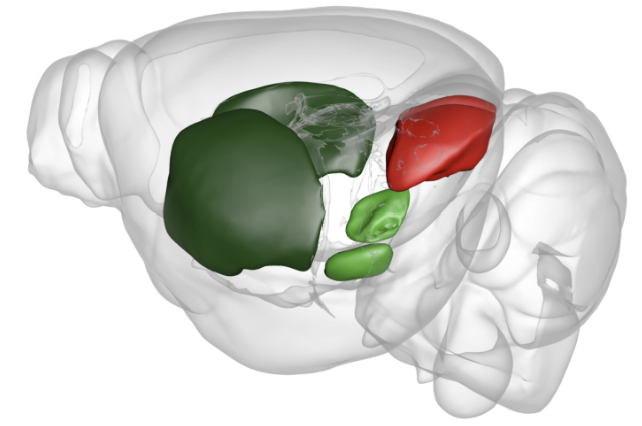Research
Midbrain circuitry mediating instrumental learning
 Vertebrates possess a remarkable capacity for learning, adapting their behavior to maximize utility (reward, safety, efficiency…). The basal ganglia comprise a set of interconnected brain structures central for action control, integrating contextual (environmental stimuli) information from the cortex and thalamus with prediction errors from dopamine. This combination of inputs and outputs allows the basal ganglia to drive ongoing behavior contingent on past experience through synaptic plasticity, something we refer to as reinforcement learning. It is however still a mystery the mechanisms by which the outputs of the basal ganglia interact with downstream structures to shape behavior during and after learning. As evidenced by the devastating consequences of neurodegeneration in the basal ganglia (e.g. Parkinson’s and Hungtington’s), their importance for human behavior is significant. A better understanding of these neuronal circuits is therefore needed before we can develop effective therapies to prevent, revert, or counteract the effects of these diseases.
Vertebrates possess a remarkable capacity for learning, adapting their behavior to maximize utility (reward, safety, efficiency…). The basal ganglia comprise a set of interconnected brain structures central for action control, integrating contextual (environmental stimuli) information from the cortex and thalamus with prediction errors from dopamine. This combination of inputs and outputs allows the basal ganglia to drive ongoing behavior contingent on past experience through synaptic plasticity, something we refer to as reinforcement learning. It is however still a mystery the mechanisms by which the outputs of the basal ganglia interact with downstream structures to shape behavior during and after learning. As evidenced by the devastating consequences of neurodegeneration in the basal ganglia (e.g. Parkinson’s and Hungtington’s), their importance for human behavior is significant. A better understanding of these neuronal circuits is therefore needed before we can develop effective therapies to prevent, revert, or counteract the effects of these diseases.
In a recent publication, we have characterized a precise area in the striatum (input nucleus of the basal ganglia) that is involved in learning an auditory-guided task in mice. This area, called the tail of striatum, gains control of the behavior progressively as the animal learns, and has defined spatial connectivity with the rest of the basal ganglia and midbrain structures. It therefore offers a unique opportunity to study the mechanisms by which the basal ganglia influence movement-related structures and exert control of behavior. We are investigating: 1- the anatomy of functional connections combining transsynaptic viral strategies with activity-based neuronal tagging. 2- the identity of the cell types that constitute the midbrain circuits modulated by the tail of striatum using high-throughput molecular techniques. 3- the functional relevance of these circuits employing pharmacological and optogenetic techniques, using behavioral modeling approaches to evaluate their contributions during learning. These experiments will reveal the identity and the role of the cell types and circuits by which the tail of the striatum influences downstream structures, adding to our understanding on the function of the basal ganglia during learning and behavior.
